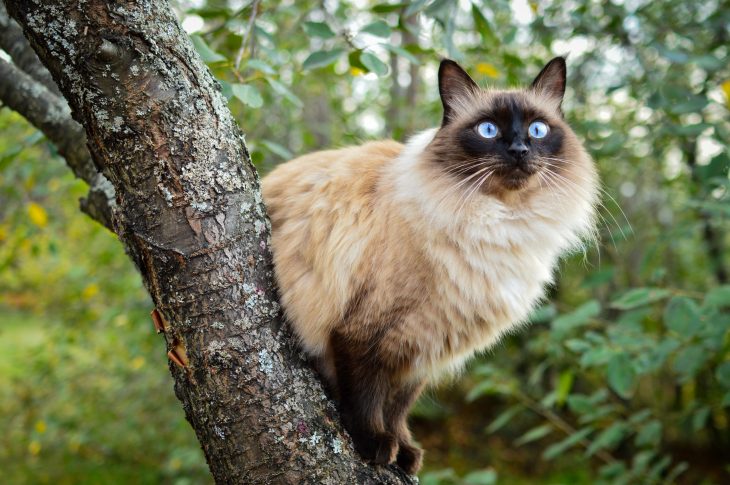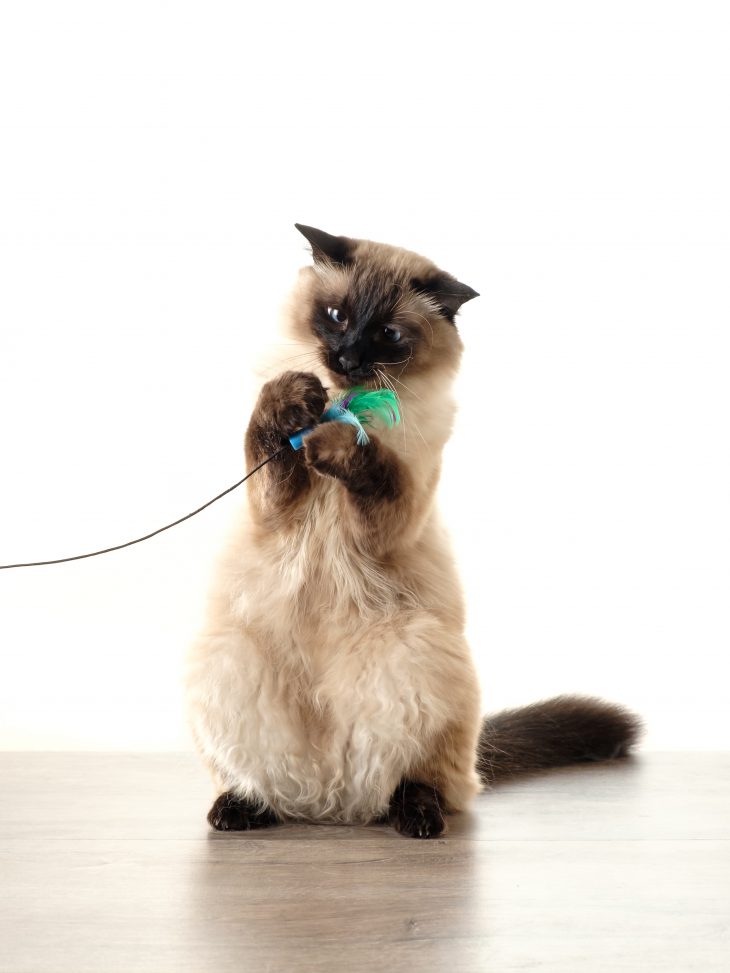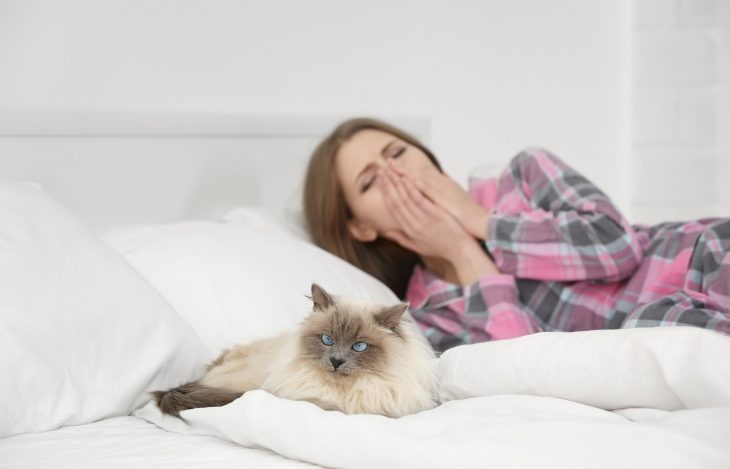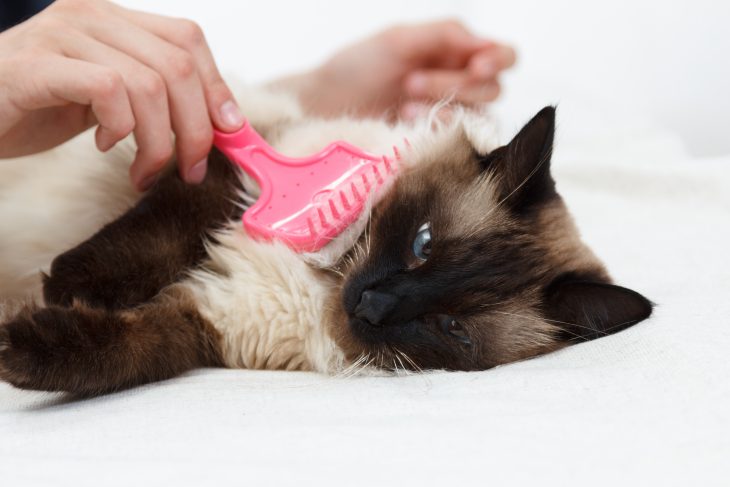Is the Balinese Cat Hypoallergenic? Advice for Allergy-Suffering Families

As far as we know, Balinese cats could potentially be hypoallergenic. But for now, there is no real research to support this. Balinese cats are said to produce less of the most common allergen, Fel d 1. Additionally, they do lack an undercoat, which means that they shed less and spread about less allergens.
The Balinese cat is known for its intelligence, goofing about and general people loving character. Vocal and adventurous, with a huge penchant towards public displays of affection, this kitty has a huge personality, as well as a huge heart. And you, as their human, had better go big or go home.

But do they truly have it all?
Are Balinese cats, in fact, hypoallergenic?
As far as we know, Balinese cats could potentially be hypoallergenic. But for now, there is no real research to support this. Balinese cats are said to produce less of the most common allergen, Fel d 1. Additionally, they do lack an undercoat, which means that they shed less and spread about less allergens.
Meanwhile, is this kitty worth the trouble of finding out just how hypoallergenic they are?
The Balinese Cat

Known for their ability to be an utter clown, yet display a high degree of intelligence, this kitty is not for the unattentive owner.
They love to play fetch, are curious about everything, and will gladly stretch their muscles by jumping onto every surface in sight. So, you better put away your valuables!
They’ll vocally tell you about their day and expect you to return the favor – with encores, of course. Additionally, you better be comfortable with PDA, because this cat will cuddle up a storm.
Intensely present in your life, they love their humans fiercely and demand to take an active part in your life, while providing you with all the free entertainment you can stomach.
As a bondus, they make a great family pet as they get on with just about anything and anyone. Granted, dogs can be a bit scary at first!

So, let’s talk about the elephant, err, hair in the room.
Do they really shed less?
While every cat sheds, the Balinese does not have a classic undercoat. This has two benefits:
- There is less hair to spread about
- Their fur does not mat as easily, which makes grooming a breeze
Additionally, they do come with another exciting perk.
They are rumored to produce less of the most common allergen that causes those pesky reactions in us humans.
Just like all cats, Balinese cats do produce the protein Fel D 1, which causes the lionshare of allergic reactions. While further research is still needed, it seems that, generally speaking, they may indeed produce less of that pesky protein, which would be good news for all those allergy sufferers out there.
Interestingly, their parent breed, the Siamese, does not have this perk. The only exception here seems to be a Siamese who has a Balinese as an ancestor. They might produce lower levels of Fel d 1, as well.
As you can tell, the amount of Fel d 1 an individual cat produces strongly depends on their genetic makeup – even within the breed! Generally speaking, kittens and females produce less of the allergen, followed by neutered males and with intact males being the worst offenders.
So, unfortunately, there are no guarantees, even within breeds that are proven to produce less of the main allergen, like the Siberian cat.
But, that shouldn’t stop you from finding out for yourself – provided your allergy isn’t the lethal kind, of course.
There are plenty of people who claim that they have limited to no reactions to their Balinese cats. There are also plenty that make it work, just by putting in a little extra work.
Handling Your Allergy

Say you want to adopt a Balinese kitty.
You’ve thought about it and you’ve done your research.
You’ve visited with the kitty you want to adopt, and spent 30+ minutes with her and her family, even rubbing her on your face, so you know what to expect (bring the benadryl!).
How do you build a comfortable life for the both of you?
Well, there are three areas of attack.
The Human Factor
There are a few things you can do yourself (or the allergy sufferer in the family), to minimize your own discomfort – and still enjoy your furry family member.
Daily routines to develop
-
Handwashing. Each time after you touch your Balinese, you wash your hands. It takes about 3 weeks to get into the habit, but it’ll be worth it to get rid of those pesky allergens before they can do too much damage. Tip: have some hand cream near the sink, as well.
-
Lovin’ laundry day Time to be judicious about regularly washing your clothes. You see, textiles tend to be a total cat hair magnet. And cat hair…well, that’s the allergen’s ride from your kitty all the way to your body. Your laundry machine will be one of the many guards you place around your body. Also, consider the materials your clothes are made of. Cottons work well enough, but polyester and wool can be real cat traps!
-
Talk to your cat. As in, teach them how to show you affection appropriately. Cats tend to show their fondness through head budding – also known as bunting – but also through licking. And saliva is another big source of cat allergens. So, walk away (and wash your hands!) when your cat starts licking. Teach them to stick to bunting, purring and cuddling by reciprocating their affection.
Seek professional help
-
Invest in an allergist. Hopefully, it’ll give you insight into how severe your allergy is, and what triggers it. They may even recommend something called ‘immunotherapy’, which is basically a series of injections to help you desensitize to your cat.
-
Visit your pharmacy. Over-the-counter medication can be your best friend. It’s one of my go-to things in my first-aid kit. While I’m not allergic, one of my friends is, so I always stock allergy pills or benadryl in case she or anyone else needs it.
-
A more natural approach**.** On the holistic front, there are in fact two treatments that have shown a lot of promise: the neti pot and plain saline nasal spray.
The Feline Factor
One of the perks of tending to the ‘feline factor’ (also known as your Balinese) is that it’ll take care of your own discomfort and provide some extra bonding time between you and your kitty.
-
Prone to dander. Evaluate how prone your kitty is to dander. Some cats have a more dull coat, where loose hairs and dander get stuck in their coat. This is exacerbated by washing your Balinese too often. One thing you can do is pick up some Omega 3 fatty acid supplements at your local pet store as those help with a smooth and shiny coat.
-
Acepromazine might help. This is a drug, prescribed by your vet that can added in very low doses to your kitty’s food. It is said to relieve symptoms in allergy sufferers significantly.
-
Bath-time is fun! Cats often have an innate dislike of water – and for good reason. Due to the lack of oil in their fur coat, they are highly susceptible to hypothermia. So, take the time to gently introduce your kitty to a nicely heated bathroom, and show her that water doesn’t have to be scary. Bring treats and provide plenty of positive attention as a reward. Washing your cat will remove the allergens from their coat, especially if you pick up a special shampoo while your at the local pet store for those Omega 3 fatty acids. Be careful not to overwash your kitty. Once a month is ideal.
-
Treat her like royalty. Brush your kitty like she is a princess. Though this is probably best done by someone who isn’t allergic (as hair goes flying), brushing the coat will keep it smooth and shiny. This will, in turn, minimize the spread of allergens around the house.
The Environmental Factor
Lastly, there is the happy and clean home mantra to adopt. In order to keep those pesky allergens from getting anywhere, I have a few neat tricks for you.
Cleaning strategies
-
HEPA Air Purifiers. Time to literally clean the air. These handheld babies will help you filter the air in any room that needs it. Consider placing one in any room that house a lot of textiles, as these tend to be cat hair magnets.
-
Time for a vacuum with a micro-filtration device (HEPA). Nowadays, they sell vacuums specifically designed to deal with pet hair. Use them religiously. Or better yet, have someone who isn’t allergic take care of this task as stuff does go flying everywhere when vacuuming.
-
Furniture Polish is your friend. Dusting often is a big help. Additionally, spray the furniture polish directly onto the shelves and surfaces as it is more effective at trapping dust that way. Properly executed, this routine may well reduce air-borne cat allergens by 95% in your home!
Textile Management
-
No Balinese in the bedroom. I know it sucks, but there is a big cat hair magnet in your bedroom: your bed. The textiles alone will trap a massive amount of allergens. And you spend 8 hours a day in there. It’s just not worth the risk, sorry.
-
Declare war on all fabrics. Try to adopt a minimalist style. As is abundantly clear by now, fabric is the enemy. It loves to trap cat hair, and house those allergens. So take a critical look at your home and remove any textile that isn’t needed from your home.
Integrating a Balinese into your life as an allergy sufferer may seem a bit daunting. But for those who are committed, it will be worth it. Their entertainment value alone is off the charts, to say nothing of their big hearts.
This cat deserves a person who will integrate them wholeheartedly into their lives, as they will return the favor without blinking.
